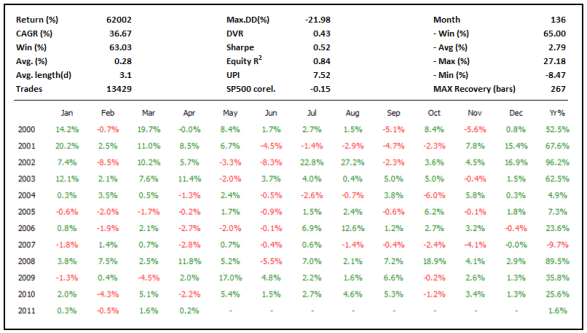With this post I want to share some of the groundwork I did for preparing a market neutral strategy. I’m a big fan of having only a very few strategies that have a constant exposure while an edge exists. Rather than having many strategies that wait for an extremely strong edge. As of today my strategy portfolio consists of two type of strategies: mean reversion and momentum.
The mean reversion strategy is trading the SPY long/short and the momentum strategy is trading Nasdaq 100 stocks with a rotational momentum approach rebalancing weekly. Furthermore I’ve got a strategy that buys country ETFs after they dipped (long only). Obviously this strategy has a certain correlation with the SPY mean reversion system. However I want to trade it in order to get some non-US exposure into my portfolio. I’m done with these strategies, of course everything can be improved. So I’m looking for a significant next step to expand my portfolio of strategies. With this post I want to share some groundwork I did in the area of market neutrality = equal long / short exposure.
Basic research
I looked into the behaviour of SP500 stocks over the course of the last 10 years. For this test a survivorship-bias free SP500 database has been used. A very basic strategy has been built: trading the SP500 with a (daily) rotational approach buy top10 or bottom10 stocks. The purpose of this strategy is to learn what position ranking will have the biggest impact on segregating winners from losers the next day. Two widely known indicators have been used: RSI and ROC. Each of them have been tested with different period settings. The stats bellow are divided into two parts. The bottom part is going long the lowest (bottom10) ranked stocks and the top part is going long the highest (top10) ranked stocks.
(click on the picture to get a slightly larger view)
All results are without slippage/commission. Data isn’t adjusted for cash dividends.
Regardless of the type of indicator or period settings going long the strongest stocks (top 10) is always a loosing proposition and vice versa going long the weakest stocks is a winning proposition.
Expectations
By definition a market neutral strategy is likely to have lower absolute return than a strategy that tries to trade in the expected direction of the market. Returns from this type of strategy are resulting from it’s ability to pick the right candidates for longs and shorts.
Test
Based on the above shown research a strategy has been created that buys the bottom 5 and shorts the top 5. stocks have been ranked using RSI(7).
(click on the picture to get a slightly larger view)
The basic idea looks promising. I’m going to continue my research in this area. My main focus will be on improving avg.% trade.
Stay tuned!
– Frank
Related posts:





